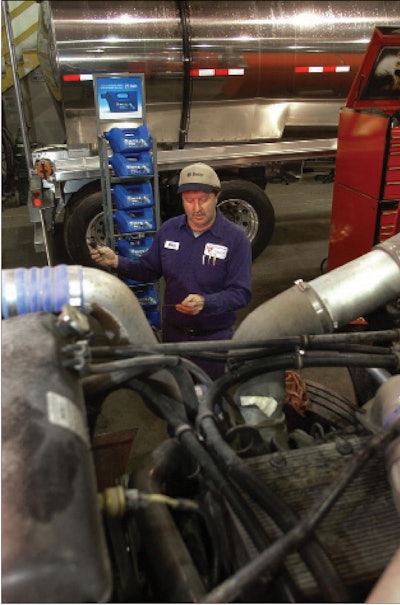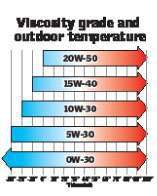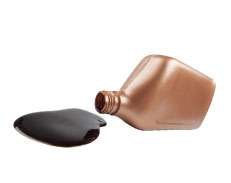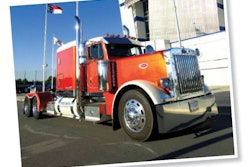Specialists weigh in on cold starts, wear protection and other oil viscosity matters.
Nine out of 10 heavy-duty long-haul trucks use 15W40 oil. Despite that long-standing domination, that viscosity might not be the best choice for all conditions and applications.
 Lighter oils help extend longevity of engine parts.
Lighter oils help extend longevity of engine parts.While 15W40 remains a solid choice for running in most temperatures and provides superior protection against engine wear, lighter viscosities offer other benefits. A 10W40, 10W30 or 5W30 oil – all widely used in Europe, where truck fuel economy standards are widespread – helps reduce fuel consumption 1 percent or more, recent studies have shown. Lighter oils might also offer better cold starting at below-zero temperatures and help extend longevity of engine parts.
Choosing the right viscosity requires knowing what your engine manufacturer recommends, ambient temperatures where you’ll be running and the needs of your application.
We asked these specialists to address questions on viscosity:
Castrol Heavy Duty Lubricants: Corey Taylor, senior heavy duty technologist
Chevron Global Lubricants; Jim Gambill, direct marketing specialist
Citgo Lubricants; Mark Betner, heavy duty product manager
ExxonMobil Lubricants and Specialties; Maria Burcham, CVL products technical advise; and

Shell Lubricants: Dan Arcy, OEM technical manager.
How important is choosing the proper viscosity?
 Lighter viscosity oils, such as 5W-30, provide improved cold starting in sub-zero temperature environments while matching heavier oil performance under operating conditions.
Lighter viscosity oils, such as 5W-30, provide improved cold starting in sub-zero temperature environments while matching heavier oil performance under operating conditions.CHEVRON: It’s one of the most important things, but not the only one. You want to make sure it meets engine manufacturer specifications (check your owner’s manual) and that it’s the latest American Petroleum Institute classification, CJ-4.
CASTROL: While owner-operators often think about what viscosity to choose, engines primarily continue to be designed to operate using 15W40 in virtually all climates.
What viscosity works best in extreme temperatures?
CASTROL: Except in very cold climates, 15W40s do well from the Mojave Desert to northern Minnesota. We do have some customers who buy our 5W-30 because of the cold start performance.
SHELL: When it’s getting down to zero degrees in Minnesota in the winter, the 15W40 is not going to be acceptable. It may mean going to a 10W30, 10W40 or 5W40. If running extreme temperatures year-round, you could select a synthetic 5W40. With the 5-weight, you could get that real low temperature performance in cold weather, and with the 40-weight, you have high-temperature film thickness you need when you’re in 100-plus-degree temperatures.
CHEVRON: If you’re an over-the-road trucker, you can feel very comfortable that a mineral 15W40 oil is the right viscosity – if you’ve got other things such as an engine block heater. Even without a block heater, our recommendation is to stay with 15W40. The oils are very well formulated and flow at very low temperatures. If running short-haul, say in the Dakotas, you might want to switch to 10W30 year-round.
CITGO: You have two choices: You can plug the engine into a block heater or use a 5W40 oil.
What are the pluses and minuses of lighter viscosities?
SHELL: You get better fuel efficiency over what you get with 15W40. In a medium-duty test we ran, we demonstrated you could get 1.6 percent less fuel consumed when using a 10W30 than with 15W40. It doesn’t sound like a bunch, but with fuel at $3 a gallon and driving 120,000 miles a year, that could mean $750 to $1,000 savings. In the long term, I think we’ll be seeing more lighter viscosity grades. It’s proven that durability is equivalent to 15W40 and you can get improvement in fuel economy.
CASTROL: A 10W30 is thinner at both ends of the temperature spectrum. Thinner oils offer less resistance to the moving parts in the engine, which turns more easily and operates more efficiently. Lower viscosity oils need to be more robust to compensate for the thinner oil. The additive packages are highly specialized to protect the engine because the oil film is thinner. In older engines (pre-2007 and especially much older models), we have heard of issues with weak oil pressure. Thinner oil is prone to result in lower oil pressure.
CHEVRON: In testing our 10W30, we found that an improved fuel economy of 1.3 percent in over-the-road trucks (versus 15W40) didn’t come at the expense of engine durability. A premium product should be able to deliver wear levels and oil drains that operators have come to expect from the leading 15W40 oils. That’s good news for operators considering a lower viscosity oil.
CITGO: Many people have what I call “viscosity fear syndrome” – they think thicker or heavier oils give better protection to the engine. In modern diesel technology, that is not true. Europe has been using 5W40 and 5W30. The U.S. Environmental Protection Agency SmartWay website urges over-the-road truckers to go with low viscosity – anything less than 15W.
EXXONMOBIL: The thinner the viscosity, the less resistance to flow it will have. The other side is if you go too thin, it will squeeze out between metal parts and won’t provide protection. It will not resist pumping at startup and move through the engine quicker.
Which is the better choice – natural (mineral oil) or synthetic?
CITGO: For a wider range of uses, a 5W40 built with synthetic base will deliver quality performance.
SHELL: Synthetics have two main benefits over mineral oils – better low-temperature performance and better high-temperature film thickness.
CHEVRON: In very cold or very hot temperatures, those are areas where I would prefer synthetics. The temperature curve is flatter with synthetics. As temperature range changes, the oil tends to remain at the same viscosity.
EXXONMOBIL: The base oil in synthetics makes it easier to achieve better starting at low temperatures. But the grade numbers mean the same, whether mineral oil or synthetic oil.
Should you change viscosities based on the seasons?
SHELL: We have customers who switch – they’ll use 15W40 in the summer and, depending where they are, they’ll switch to a 5W40 or 10W30 in the winter.
EXXONMOBIL: That’s the beauty of multi-grade oils. They are able to provide protection at lower and higher temperatures. If you pick the viscosity numbers correctly, you wouldn’t have to change oils for the season.
CITGO: There was a fleet in Chicago that discovered through oil analysis that when they departed from 15W40, they reduced their iron wear significantly during winter months by going to higher fluidity, lower viscosity oil. More engine wear can occur at startup. During startup, if you don’t have a proper oil film, you’re going to wear that engine at a greater rate.

EXXONMOBIL: Look at your application. Does it put a lot of stress on the motor, like heavy hauling? That would be more applicable to higher viscosity grades. It provides greater film between parts to stand up to more wear and tear.
SHELL: Not really, but it depends on the ambient temperatures.
CITGO: Pulling heavy loads doesn’t require a specific oil or viscosity. That’s the perception, but it’s not true.
What is the best solution for cold starts?
CITGO: If an oil doesn’t flow well below 15 degrees, you’re going to increase wear, put more stress on the starter and more stress on the batteries. The more you crank the engine, the more you’re going to shorten the starter life, and pulling a battery below 80 percent of its capacity, you’ll shorten battery life.
CHEVRON: A 10-grade will give you a quicker cold start than 15-grade.
Any oil grades you don’t recommend?
SHELL: You don’t want to use straight grade engine oils, such as straight 30 or straight 40. I still see them on retail shelves. They are old technology and don’t come close to meeting standards for durability or wear protection for modern engines, and they aren’t going to pump as well at low temperatures. n
What those numbers mean
The first number, such as the 15 in 15W40, identifies the cold starting viscosity, or resistance to flow or speed of flow. The lower the number, the lower the relative ambient temperature at which the oil could quickly flow and provide cold cranking power. Ratings are determined by the Society of Automotive Engineers.
The second number refers to the oil’s viscosity when hot under normal operating temperatures of 210 degrees Fahrenheit.
“W” commonly refers to winter, meaning the oil has been tested at cold temperatures.
“Diesel has the widest performance range with 5W40,” says Mark Betner of Citgo. “Its starting temperature range is down to minus 22 F (compared with 15-plus with 15W40) up to 122 degrees F (same as 15W40). That tells you a couple things: There’s a 37-degree cold cranking advantage (from minus 22 to plus 15) to a 5W40 and the same benefit on the high end.”
Oil for APUs
Increasing usage of auxiliary power units is reducing idling and fuel consumption. Yet if you don’t pour the proper oil, your APU may not work when you need it most. APU oil recommendations vary depending on the manufacturer, says Chevron’s Jim Gambill. For example, Comfort Master recommends a lighter viscosity, such as 5W40, 5W20 or 10W30. Kubota, he says, recommends a CD-class oil that won’t be allowed after 2010, or the same oil you’re using in your truck engine.
Dan Arcy of Shell Lubricants says you need to know your APU’s capabilities and where you will be running. If you have an APU that’s designed to heat the engine block, 15W40 oil will be sufficient year-round. If your APU doesn’t have that feature, he recommends using 5W-40 for better cold starts.
Mark Betner of Citgo Lubricants is of the same mind. He recalls a Western fleet that purchased 400 APUs. Some trucks traveled through Rocky Mountains and parked overnight in minus-30-degree temperatures. When they went to start the APUs, they wouldn’t turn over. He says, “15W40 was the problem all over again. That small 2-cylinder APU diesel had the same struggles as the big diesel does, only on a smaller scale.”
Longer interval, better viscosity
Every time owner-operator Earl Evans changes oil, he takes a sample for analysis. He does this to monitor metal deposits and wear on the 550-hp Caterpillar in his 2005 Kenworth W900L, which has 900,000 miles.
With the introduction of American Petroleum Institute standard CJ-4 oils four years ago, he has extended drain intervals to 25,000 miles from 12,000. Despite the longer periods between changes, Evans says the wear rates are the same as he saw at 12,000-mile intervals. “The viscosity is better at 25,000 miles than it was with the other oil at 12,000 miles,” he says.
After extensive testing, oil manufacturers have said that CJ-4 oils can reduce wear on engine parts and protect against high operating temperatures, both of which can allow operators to increase drain intervals. Performing regular oil sampling will provide important information about wear rates.
Like most long-haul operators, Evans uses 15W40. He ensures reliable cold starts with an engine block heater and oil pan heater that are wired together. “When it gets down below zero, like in Wyoming, I start the heater,” he says. “The oil pan is insulated and holds enough heat so it’s not a complete cold start.”
Despite his success with 15W40 and his truck’s equipment, Evans says he would choose a synthetic oil with a low viscosity, such as 5W40, for his next truck “to give me that much more protection. I won’t do it with this truck until I rebuild the engine.”












